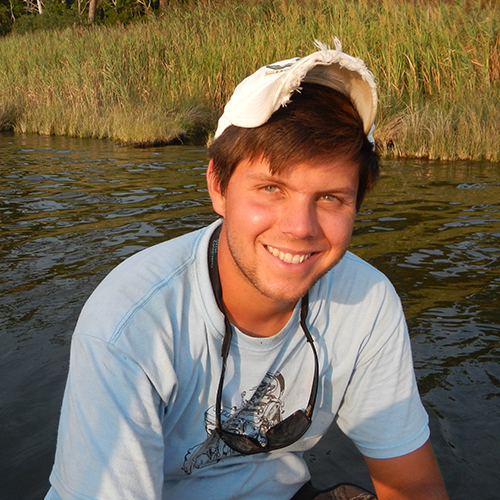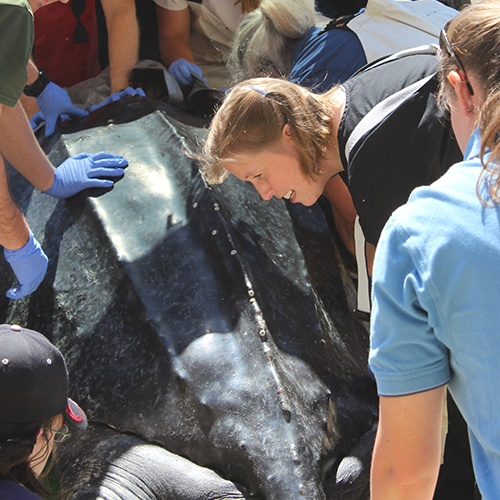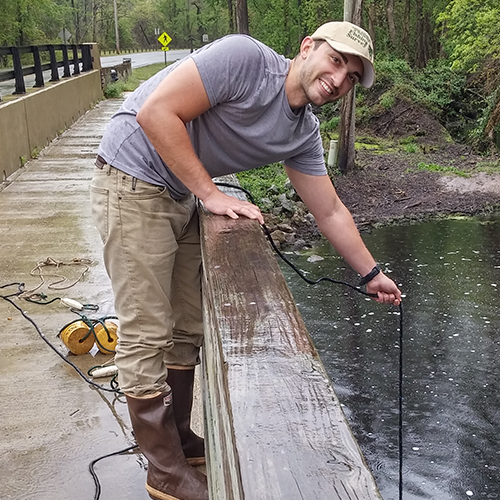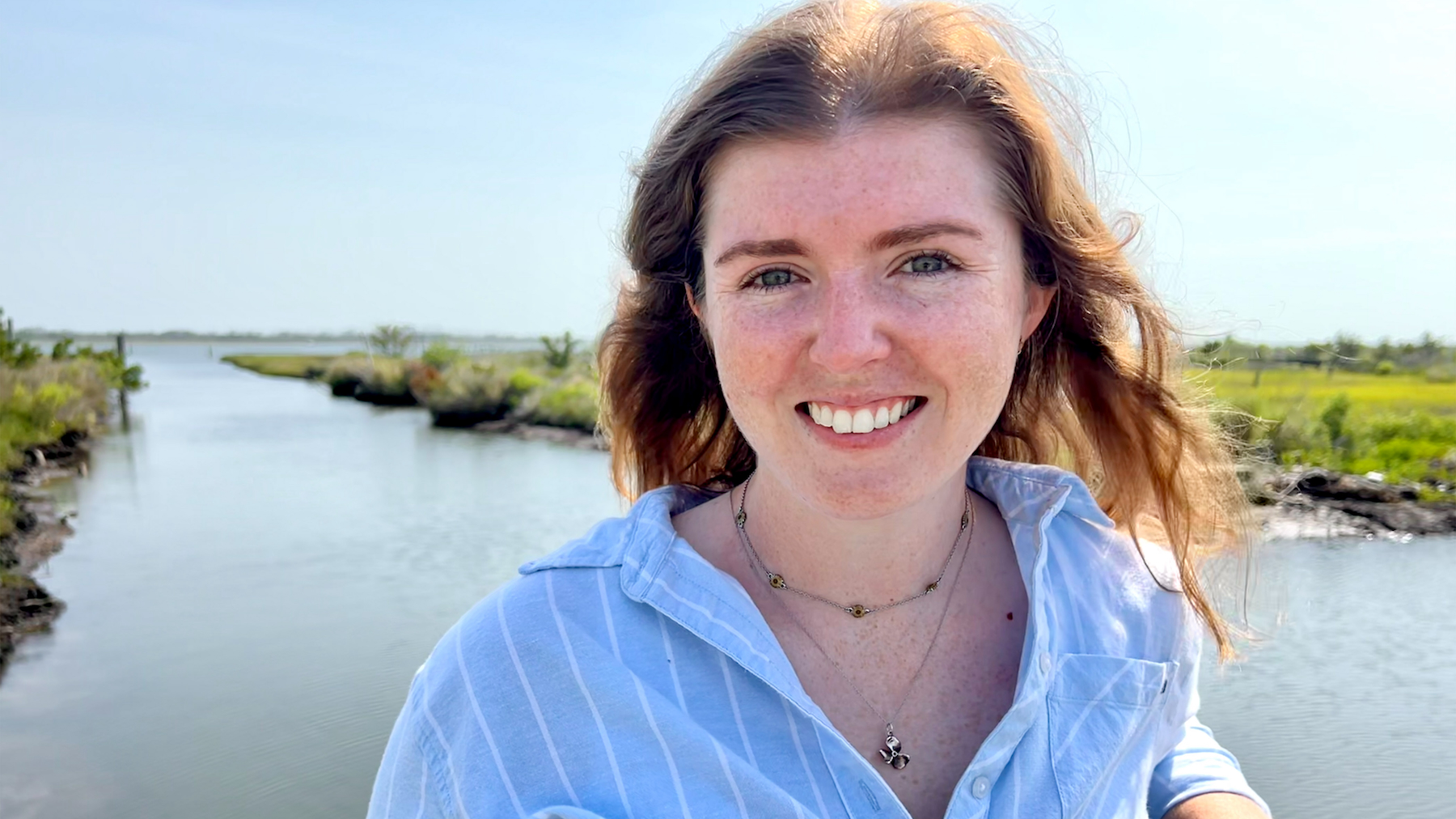Spotlight on our Students
Graduate students and CVM residents are a big part of CMAST. In this article, we highlight a few of our rising stars.
 Seth Theuerkauf, PhD Student
Seth Theuerkauf, PhD Student
Seth Theuerkauf knew very early that he wanted to work towards protecting and improving the ecology of the marine environment. Through intense work at CMAST, he is well on his way to a stellar career in his field.
My passion for science to inform marine conservation and restoration efforts stems from early experiences working on Chesapeake Bay oyster reef restoration projects at the Virginia Institute of Marine Science (VIMS) as a high school student. As an undergraduate at William and Mary, I continued to work at VIMS and develop skills through coursework and research experience that allowed me to positively contribute to Chesapeake Bay restoration and conservation efforts. My PhD research at NC State has allowed me to continue developing ecological and geospatial skills that will be useful throughout my career as a marine conservation biologist.
As a PhD Candidate in Dr. David Eggleston’s marine conservation ecology group based at NC State-CMAST, I conducted field-, laboratory-, and geospatial analysis-based marine conservation ecology research to empower state and federal coastal resource managers with information and geospatial tools needed to better conserve and manage coastal resources (such as saltmarshes and oyster reefs). To learn more about the specifics of my research, please visit my website at: seth.wordpress.ncsu.edu
Armed with a suite of ecological and geospatial knowledge and research tools acquired throughout my education, I intend to dedicate my career to advancing science to inform effective restoration and responsible management of America’s coastal and estuarine ecosystems and the livelihoods and traditions that they support.
I began my PhD program in August of 2013 and anticipate completion this October (2017).
I have worked at CMAST since the summer of 2013, but relocated permanently to CMAST in May of 2015. The unparalleled resources available at CMAST, including access to research vessels and vehicles, laboratory and field equipment, and ample space and modern facilities have allowed me to conduct, analyze, publish, and disseminate cutting-edge marine conservation research. Furthermore, CMAST’s prime location–adjacent to academic, state and federal research labs and agencies–allows the research products generated by myself and others at CMAST to be directly applied and to contribute to coastal solutions for North Carolina.
In August 2017, I began a new job as a PhD-level Conservation Scientist on a joint program between the National Oceanic and Atmospheric Administration and The Nature Conservancy to apply geospatial tools to predict optimal locations for shellfish aquaculture. The position is located in the Washington, D.C. area.
 Kathrynlynn Theuerkauf, MS Student
Kathrynlynn Theuerkauf, MS Student
My interest in marine ecology and conservation biology began during my junior year of high school, where I worked at the Virginia Institute of Marine Science (VIMS), where I had the exciting opportunity to work alongside research scientists and others from government and non-profit groups on the science supporting Chesapeake Bay restoration projects. As an undergraduate at William and Mary, I worked as a Laboratory Technician with the Marine Biodiversity laboratory at VIMS where I participated in an ongoing, international research project that quantifies the role of anthropogenic stressors on seagrass production globally. These experiences sparked my interests in the impacts of climate change and invasive species on ecosystem health and led me to pursue a master’s degree within the Marine Conservation Ecology laboratory at NC State University.
I am a master’s student in Dr. David Eggleston’s Marine Conservation Ecology laboratory based at CMAST. The Marine Ecology and Conservation Program aims to test ecological concepts in coastal and marine systems by answering questions that refine concepts, and provide answers that can be applied to conservation or restoration of fisheries species and important habitats.
My current National Science Foundation (NSF) Graduate Research Fellowship-funded master’s research furthers our understanding of the processes that shape how biological communities within marine systems develop over time, and the impacts of environmental change and invasive species on those processes. Specifically, I am evaluating the role of an invasive species in altering patterns of community development and reducing biodiversity within the marine fouling community of Beaufort, NC.
I plan to pursue a career as a marine conservation biologist working with a government agency or non-profit organization.
I began working on my degree in August 2014 and anticipate completion in September 2017.
I came to CMAST in May 2015 after completing my required coursework in Raleigh. I was awarded an internship at NOAA’s National Center for Coastal Ocean Science in Beaufort, North Carolina through the NSF Graduate Research Internship Program. As an intern, I conducted an interdisciplinary research project to determine if Marine Protected Areas within the U.S. Virgin Islands harbor hotspots of marine biodiversity and threatened and/or endangered species and if not, identifying locations that may be optimal for future protection. The close proximity of CMAST to other state and federal research labs, like NOAA, has allowed me the exciting opportunity to gain valuable professional development skills that will help me succeed in my future career.
I have accepted a position with the Environmental Science Division of The Pew Charitable Trusts with their Conservation Science Program in Washington, DC, and will defend my degree September 2017.
 Sara Cannizzo, CVM Resident
Sara Cannizzo, CVM Resident
The Residency in Zoological Medicine is a 3-year program of advanced training for graduate veterinarians specializing in zoo, wildlife, aquatic and exotic animal medicine. Objectives are to prepare the resident for certification by the American College of Zoological Medicine (ACZM), and provide training in clinical research. Credentialing to sit the 2-day ACZM examination requires extensive clinical experience with a broad range of species, authoring at least five papers for publication, and intense study of the zoological medicine literature. Dr. Sara Cannizzo is in the zoo-focus of the residency (we also have aquatics-focus and zoological companion animal-focus positions), but all positions cross-train in the other areas. Dr. Cannizzo has successfully credentialed to sit the ACZM board examination, and has accepted a position at the Fort Worth Zoo following the completion of her residency this summer.
I studied Folklore and Mythology at Harvard University. After I graduated from Harvard, I received an MA in Irish Heritage Management at University College, Cork in Ireland. I spent a summer traveling around Ireland with a pre-vet student.
Hearing her stories piqued my interest in veterinary medicine and specifically zoo medicine. I attended veterinary school at the University of Pennsylvania. After veterinary school, I completed a small animal rotating internship and a zoo internship. I then came to NC State University for the Zoological Medicine Residency. Working in a zoo allows me to combine my veterinary degree with my graduate work in conservation.
I am in the final (third) year of my zoological medicine residency. Zoological Medicine residents spend time at the College of Veterinary Medicine, the NC Zoo, and here at CMAST. While we are at CMAST we provide veterinary services for the three NC Aquariums and the Karen Beasley Sea Turtle Rescue and Rehabilitation Center. We also participate in The Marine Mammal Stranding Network for the Central Coast of North Carolina.
My goals are to become a zoo veterinarian and become a diplomate of the American College of Zoological Medicine, which is an organization of veterinarians who have specialized in zoological medicine
As a zoo-focused zoological medicine resident, I spend 2-3 months each year of my residency at CMAST. I have really enjoyed working with the Karen Beasley Sea Turtle Rescue and Rehabilitation Center. Another highlight of my CMAST rotations was a diagnostic work-up for a sand tiger shark.
 Steve Lombardo, MS Student
Steve Lombardo, MS Student
Steve Lombardo is a graduate student in the Department of Applied Ecology pursuing a M.S. degree in Fisheries, Wildlife, and Conservation Biology. He is investigating spatial and temporal patterns in river herring spawning in the Albemarle sound watershed using a 40-year data set. As part of his research, Steve spent two springs working with NC Division of Marine Fisheries personnel to assist and familiarize himself with the river herring spawning survey.
Like most people in our field, I never outgrew my childhood fascination with all things aquatic and fish as a child. I was fortunate to have some amazing teachers that were able to hone that general curiosity into an analytical curiosity. I received my B.S. in biology from the University of Akron in 2012.
After graduating, I spent two and half years as a wet/radiological chemist and field technician for an environmental consulting firm. I did a lot of work with drinking water quality and fracking waste. It was during my time as a chemist that I got in contact with Dr. Jeffrey Buckel, my advisor, about joining his lab group as a master’s student.
I looked to join Dr. Buckel and NC State University because of their unique relationship and influence on many of the state and federal fisheries agencies, which has provided me many opportunities to work directly with those agencies. I didn’t get the position, but staying prepared, expanding my fisheries experience, and being persistent led to me to joining the lab a year later.
For the year between interviews with Dr. Buckel I worked for the Ohio Department of Natural Resources Fisheries Research Unit as a creel clerk along the shores of Lake Erie and regularly volunteered with the Cleveland Metroparks as a fisheries technician.
As a second year master’s student in Dr. Buckel’s lab, my thesis work is focused on looking at the spatial and temporal fluctuations in utilized spawning habitat by river herring in the Albemarle Sound watershed. River herring is the collective name for two anadromous forage fish species, alewife (Alosa pseudoharengus) and blueback herring (Alosa aestivalis).
River herring are a culturally and ecologically important species to North Carolina and throughout their range, which roughly spans from Nova Scotia to Florida. The population of these two species crashed in the 1970s due to overfishing, bycatch in Atlantic fisheries, and habitat degradation.
I am working with the North Carolina Division of Marine Fisheries to analyze data from their spawning area survey, which identifies spawning habitat in tributaries throughout the Albemarle Sound watershed. I am using ArcGIS mapping software to spatially analyze how land use changes, culvert construction, and other environmental influences have impacted the ability of river herring to reach and utilize potential spawning habitat.
The information from these analyses can be used to prioritize remediation of tributaries, culverts, and riparian zones that would provide the greatest increase to available spawning habitat.
There are so many different and interesting facets to our field that I tend to keep my career goals pretty loose and free. I have a love and appreciation of the analytical, creative, and human components to fisheries science. So with that being said, I’d be pretty happy working any position ranging from a stock assessment scientist with the National Marine Fisheries Service to a science communication specialist with any of the fisheries councils or an NGO.
I’m in my fourth semester out of a scheduled five semesters. I’m hoping to defend my thesis this December.
I came to CMAST in May of 2016, after spending the previous fall and spring semesters in Raleigh and Elizabeth City, respectively. I don’t really get to spend too much time at CMAST since my fieldwork takes me away to work with the NC Division of Marine Fisheries in Elizabeth City for a good portion of the year. My experiences are pretty unique for a graduate student, getting to spend half of my time in a professional fisheries management environment.
I have worked with the NCDMF biologists on their river herring program and American shad tagging program in the Albemarle Sound, been a part of the NMFS Southeastern Fisheries Independent Survey (SEFIS) where we were out at sea for a week and half researching the red snapper population (might be the coolest thing I’ve ever done), I’ve joined in on teaching our Semester at CMAST students some fisheries management techniques, and another awesome experience is that our lab works closely with the Big Rock blue marlin fishing tournament to collect data and biological samples from the fish caught.
- Categories:


